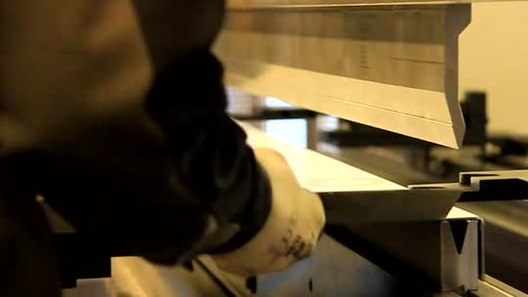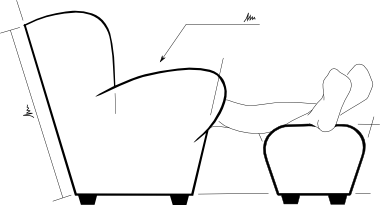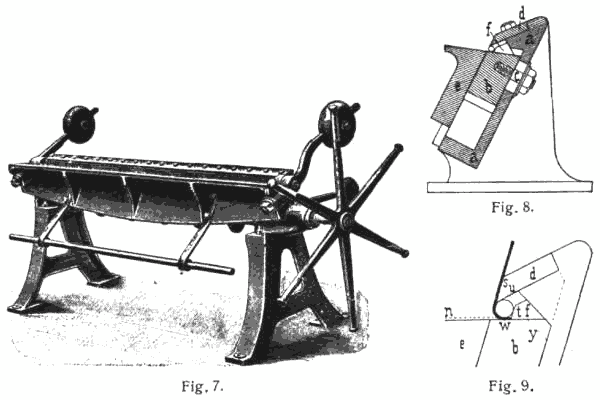The forces of folding
or: “Why folding 3mm Aluminium is out-of-reach of most home builders”
There are two main tools for bending sheet metal, a bending brake or a press brake. In an industrial manufacturing environment, the press brake is most commonly used, as it is the more adaptable and, with the computer control, can produce a set of sequential bends to swiftly produce multi-bend parts.
- Bending brake: The metal sheet is clamped and the free side is forced round a former with a radiussed edge (more detail on bending brakes).
- Press brake: The two dies close to put the sheet in three point bending along the bend line. In air-bending, where the sheet doesn’t touch the sides of the die, the top jaw doesn’t have a radius; the bend radius is determined by the jaw width and sheet thickness. The stroke depth determines the bend angle.
 ](http://marksabino.com/defproc/blog/uploads/2011/08/Proform_e_White_Background_2_DSC_4042.jpg)
An Industrial Press Brake
](http://marksabino.com/defproc/blog/uploads/2011/08/Proform_e_White_Background_2_DSC_4042.jpg)
An Industrial Press Brake
Usage:
For the bent parts in Atomic Duck, a bending brake is not suitable for two reasons. One, the metal thickness is too high; heavy duty, manual bending brakes might bend 14SWG/2.03mm steel (22SWG/0.711mm is typical), but the Atomic Duck parts are 3mm thick, tempered, aircraft grade aluminium. And two, the bend profiles for many of the parts are too close together, and will foul in a bending brake for the secondary bends.
Using a brake press is possible, and the parts are designed to be formed this way. The clearance around the upper die is enough to allow parts to be formed with close, perpendicular bends; as shown in this video:
 Press Brake Air Bending Video.
Press Brake Air Bending Video.
(Source.)
Is possible to use press brake in the home workshop? Yes. Press break dies can be fitted to a vise or bearing press, but the limiting factors are bend width and jaw closing force. The closing distance must also be carefully controlled to bend to the correct angle.
For example: the longest bend length for any part in Atomic Duck M0.1 is around 1m, the bending force for 3mm thick aluminium at 7mm radius is approximately 10 Tonnes/metre (98.07 kN/m). So the total die closing force required then is 98078N (10 tonnes).
While this load and bending length is just not possible in a vice, it may be possible to use a 20 tonne workshop press (similar to this one from Harbour Freight) with a press brake kit (like this one from Swag Offroad).
Incidentally, with its 2” wide bottom die, the Swag Offroad kit would produce approximately an 8mm radius for 3mm thick Aluminium.



alphydan wrote, “Given the price of the harbour fright press plus the press brake kit (about £200 GBP) ... one could be purchased per country and then shipped around to each builder ... (totalling a less than 2% of the total cost as soon as there are a few orders). One could buy the materials + plans + rental of press for 1 week from the last person who used it. Does that business model make sense? It seems it would really bring the cost down. And I would be willing do to something like that (including renting the van ~50GBP) ... to get a < £1000 velomobile. Can the design be adapted to the 8mm radius for 3mm?”